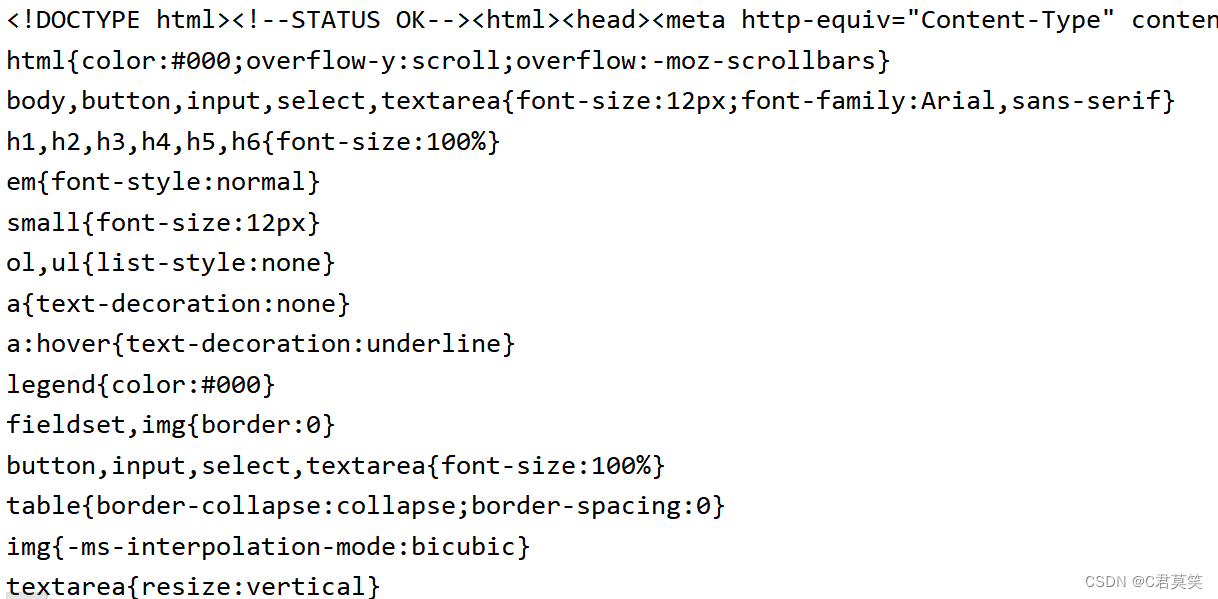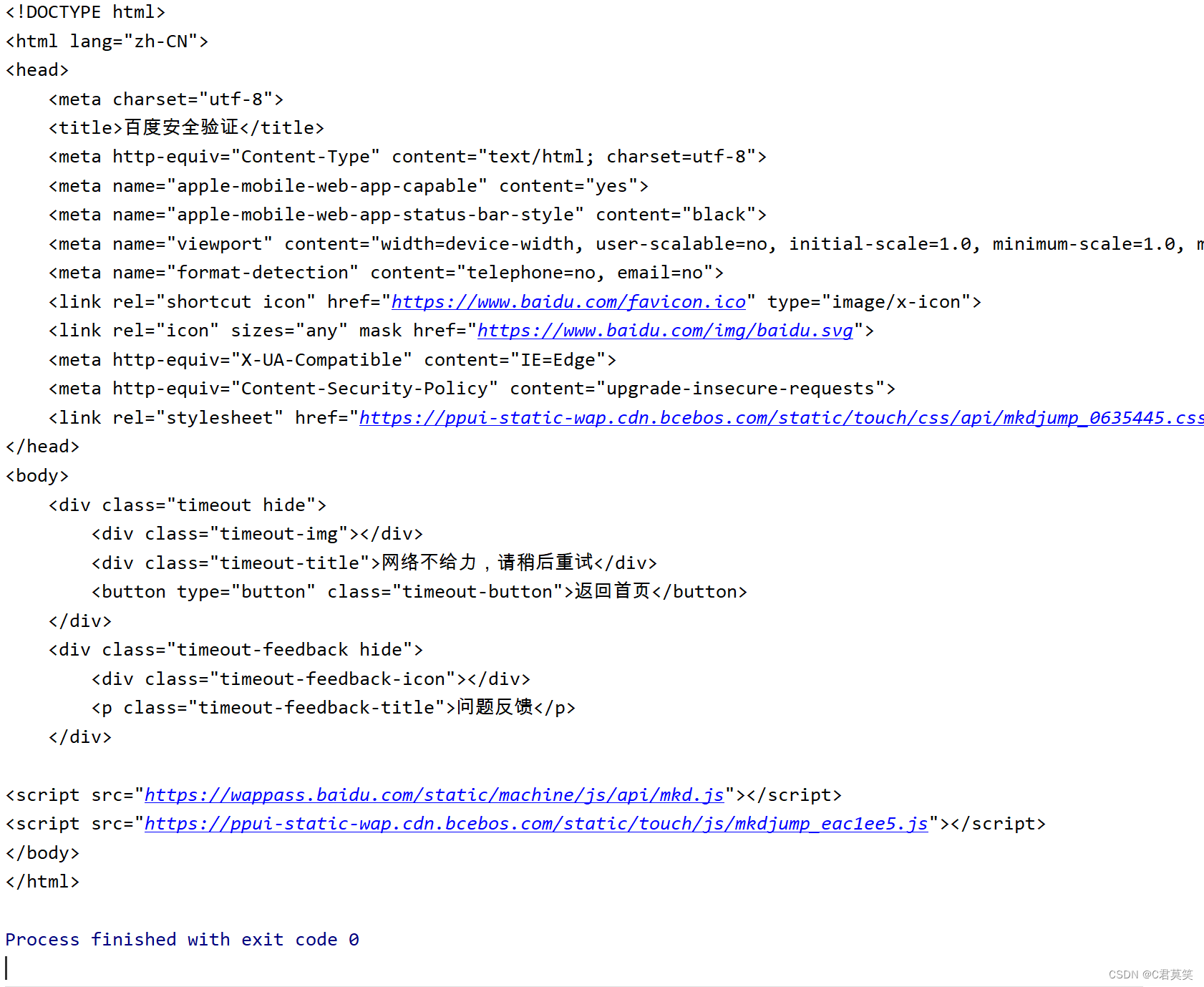文章目录
在使用Python爬虫时,需要模拟发起网络请求,主要用到的库有requests库和python内置的urllib库,一般建议使用requests,它是对urllib的再次封装。
Python两大爬虫库
urllib库
urllib 包 包含以下几个模块:
- urllib.request - 打开和读取 URL。
- urllib.error - 包含 urllib.request 抛出的异常。
- urllib.parse - 解析 URL。
- urllib.robotparser - 解析 robots.txt 文件。

urllib库使用
urllib库的response对象是先创建http,request对象,装载到reques.urlopen里完成http请求。
返回的是http,response对象,实际上是html属性。使用.read().decode()解码后转化成了str字符串类型,decode解码后中文字符能够显示出来。
urllib.request
urllib.request 定义了一些打开 URL 的函数和类,包含授权验证、重定向、浏览器 cookies等。
urllib.request 可以模拟浏览器的一个请求发起过程。
我们可以使用 urllib.request 的 urlopen 方法来打开一个 URL,语法格式如下:
urllib.request.urlopen(url, data=None, [timeout, ]*, cafile=None, capath=None, cadefault=False, context=None)
- url:url 地址。
- data:发送到服务器的其他数据对象,默认为 None。
- timeout:设置访问超时时间。
- cafile 和 capath:cafile 为 CA 证书, capath 为 CA 证书的路径,使用 HTTPS 需要用到。
- cadefault:已经被弃用。
- context:ssl.SSLContext类型,用来指定 SSL 设置。
实验案例:
import urllib
from urllib.request import urlopen
# get请求
response = urllib.request.urlopen('http://www.baidu.com')
print(response.read().decode('utf-8'))
# push请求
data = bytes(urllib.parse.urlencode({
'word': 'hello'}), encoding='utf-8')
response = urllib.request.urlopen('http://www.baidu.com', data=data)
print(type(response))
print(response.status)
print(response.getheaders())
print(response.getheader('Server'))
try:
response = urllib.request.urlopen("http://www.baidu.com/no.html")
except urllib.error.HTTPError as e:
if e.code == 404:
print(404) # 404

模拟头部信息
我们抓取网页一般需要对 headers(网页头信息)进行模拟,这时候需要使用到 urllib.request.Request 类:
class urllib.request.Request(url, data=None, headers={
}, origin_req_host=None, unverifiable=False, method=None)
- url:url 地址。
- data:发送到服务器的其他数据对象,默认为 None。
- headers:HTTP 请求的头部信息,字典格式。
- origin_req_host:请求的主机地址,IP 或域名。
- unverifiable:很少用整个参数,用于设置网页是否需要验证,默认是False。
- method:请求方法, 如 GET、POST、DELETE、PUT等。
import urllib
from urllib import request
#请求头
headers = {
"User-Agent": 'Mozilla/5.0 (Windows NT 10.0; Win64; x64) AppleWebKit/537.36 (KHTML, like Gecko) Chrome/64.0.3282.186 Safari/537.36'
}
# wd = {
"wd": "hello"}
# url = "http://www.baidu.com/s?"
url = 'https://www.runoob.com/?s=' # 菜鸟教程搜索页面
keyword = 'Python 教程'
key_code = urllib.request.quote(keyword) # 对请求进行编码
url_all = url+key_code
req = request.Request(url_all, headers=headers)
response = request.urlopen(req)
print(type(response))
print(response)
res = response.read().decode()
print(type(res))
print(res)

requests库
requests库调用是requests.get方法传入url和参数,返回的对象是Response对象,打印出来是显示响应状态码。
requests的优势:
Python爬虫时,更建议用requests库。因为requests比urllib更为便捷,requests可以直接构造get,post请求并发起,而urllib.request只能先构造get,post请求,再发起。
实验案例–get请求
import requests
# 1.基本get请求
response = requests.get('http://www.baidu.com')
print('response\n',response)
# 2.带参数的get请求
response2 = requests.get('http://www.baidu.com/get?name=germy&age=22')
print('response2\n',response2)
# 3.将参数传入params参数中来实现2中一样的功能
data = {
'name': 'germy',
'age': 22
}
response3 = requests.get('http://www.baidu.com', params=data)
print('response3\n',response3)
# 4.解析jason(如果返回结果是一个json, 则调用该方法就可以直接返回json)
response4 = requests.get('http://httpbin.org/get')
print('response4\n',response4)
# 5.获取二进制数据(图片, 视频...)
response5 = requests.get('http://github.com/favicon.ico')
with open('icon.ico', 'wb') as f:
f.write(response5.content)
# 6.添加headers(传入headers参数)
headers = {
'User-Agent': '...'
}
response6 = requests.get('http://zhihu.com', headers=headers)
print('response6\n',response6)
实验案例–抓取网页
import requests
url = 'http://httpbin.org/get'
params = {
'name': 'germey',
'age': 25
}
r = requests.get(url, params = params)
print(type(r.json()))
print(r.json())
print(r.json().get('args').get('age'))
实验案例–响应
响应是指在发送请求后,服务器返回的数据,在上面例子中,我们通过响应的 text 以及 content 获取了响应内容,此外,还可以通过其他方法来获取其他属性值,比如状态码、响应头、Cookies
import requests
# 1.基本get请求
r = requests.get('http://www.baidu.com')
print(type(r.status_code), r.status_code)
print(type(r.headers), r.headers)
print(type(r.cookies), r.cookies)
print(type(r.url), r.url)
print(type(r.history), r.history)

在上面的例子中, status_code , cookies ,history 分别代表响应的状态码,cookie 以及请求历史。
在这里需要注意的是,status_code 状态码就是 HTTP 请求状态码,比如 200 代表请求成功,404 代表资源不存在等,具体可以查阅相关资料。因此,在爬虫代码中,我们就可以通过这个状态码来判断是否请求成功,从而方便做相应的处理。
import requests
r = requests.get('http://www.baidu.com')
if not r.status_code == requests.codes.ok:
print('不OK')
else:
print('Request Successfully!')
在这里,我们用 requests.codes.ok 代表200状态,这样就不用自己手写200等数字,比较方便。当然,也还有其他内置的状态码,在下面会列出一些比较常用的,供大家参考:
# 信息性状态码
100: ('continue',),
101: ('switching_protocols',),
102: ('processing',),
103: ('checkpoint',),
122: ('uri_too_long', 'request_uri_too_long'),
# 成功状态码
200: ('ok', 'okay', 'all_ok', 'all_okay', 'all_good', '\\o/', '✓'),
201: ('created',),
202: ('accepted',),
203: ('non_authoritative_info', 'non_authoritative_information'),
204: ('no_content',),
205: ('reset_content', 'reset'),
206: ('partial_content', 'partial'),
207: ('multi_status', 'multiple_status', 'multi_stati', 'multiple_stati'),
208: ('already_reported',),
226: ('im_used',),
# 重定向状态码
300: ('multiple_choices',),
301: ('moved_permanently', 'moved', '\\o-'),
302: ('found',),
303: ('see_other', 'other'),
304: ('not_modified',),
305: ('use_proxy',),
306: ('switch_proxy',),
307: ('temporary_redirect', 'temporary_moved', 'temporary'),
308: ('permanent_redirect',
'resume_incomplete', 'resume',), # These 2 to be removed in 3.0
# 客户端错误状态码
400: ('bad_request', 'bad'),
401: ('unauthorized',),
402: ('payment_required', 'payment'),
403: ('forbidden',),
404: ('not_found', '-o-'),
405: ('method_not_allowed', 'not_allowed'),
406: ('not_acceptable',),
407: ('proxy_authentication_required', 'proxy_auth', 'proxy_authentication'),
408: ('request_timeout', 'timeout'),
409: ('conflict',),
410: ('gone',),
411: ('length_required',),
412: ('precondition_failed', 'precondition'),
413: ('request_entity_too_large',),
414: ('request_uri_too_large',),
415: ('unsupported_media_type', 'unsupported_media', 'media_type'),
416: ('requested_range_not_satisfiable', 'requested_range', 'range_not_satisfiable'),
417: ('expectation_failed',),
418: ('im_a_teapot', 'teapot', 'i_am_a_teapot'),
421: ('misdirected_request',),
422: ('unprocessable_entity', 'unprocessable'),
423: ('locked',),
424: ('failed_dependency', 'dependency'),
425: ('unordered_collection', 'unordered'),
426: ('upgrade_required', 'upgrade'),
428: ('precondition_required', 'precondition'),
429: ('too_many_requests', 'too_many'),
431: ('header_fields_too_large', 'fields_too_large'),
444: ('no_response', 'none'),
449: ('retry_with', 'retry'),
450: ('blocked_by_windows_parental_controls', 'parental_controls'),
451: ('unavailable_for_legal_reasons', 'legal_reasons'),
499: ('client_closed_request',),
# 服务端错误状态码
500: ('internal_server_error', 'server_error', '/o\\', '✗'),
501: ('not_implemented',),
502: ('bad_gateway',),
503: ('service_unavailable', 'unavailable'),
504: ('gateway_timeout',),
505: ('http_version_not_supported', 'http_version'),
506: ('variant_also_negotiates',),
507: ('insufficient_storage',),
509: ('bandwidth_limit_exceeded', 'bandwidth'),
510: ('not_extended',),
511: ('network_authentication_required', 'network_auth', 'network_authentication')